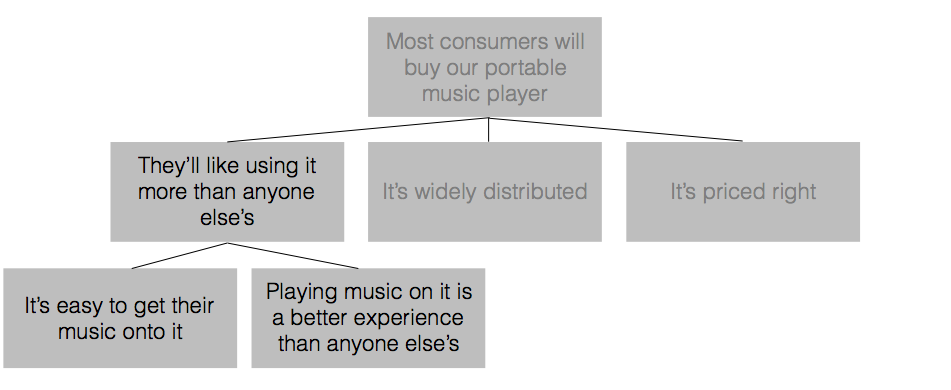Apple Ate Sony’s Lunch
In 1989 Sony dominated the personal music player market with 50% US market share, and still led the market in 2000 as CDs took over from cassettes. By 2008, mp3 players had become the market standard for portable music, and Apple had up to 86% share depending on which survey you looked at. Sony was nowhere. Apple did this despite being late to this market and not having a better player: in third party reviews the iPod is typically rated below Sony’s and other suppliers’ products.
A Simple Logic Tree Shows What’s Important
To understand what went wrong, in a way that anyone could have worked out at the time with no need for wisdom in retrospect, we can use a simple logic tree.
Here’s a simple logic tree that lays out the key things that need to be true for a company to dominate the portable music player market. It’s hard to argue that any of that wasn’t obvious even before mp3 was becoming a usable technology
A Logic Tree at the Next Level Reveals Obvious insights
Logic trees tend to reveal useful and obvious things once you expand them, which is what happens if I expand the bottom left leg of the tree.

This bottom left hand box is where the changes happened with mp3. It was no longer just about the experience of using the player, where Sony excelled, it was also about getting your music onto it. People were no longer putting cassettes and CDs into players; they were uploading tracks from CDs, downloading them from websites, or sharing them using services like Napster. So the manufacturer’s player needed to work well with the systems used to download, store and organise music, systems like iTunes.
Apple realised the importance of the bottom left box and did something about it. It grew the iTunes library to 1.5m songs in 2 years after launch, and its devices were the only ones compatible with iTunes’ format. By 2009, iTunes consumers had downloaded 8 billion songs. These only generated ~$800m revenue for iTunes; but they made iTunes the default music management system, and that laid the ground for $22bn in sales of iPods.
More Than Wisdom in Retrospect
It’s easy now to look back at how things turned out and be tricked into thinking that Apple must have had some overriding advantage. But Apple didn’t even have a music store until 2 years after it launched the iPod in 2001, when Sony was one of the biggest music companies in the world. So Sony had some outstanding advantages of its own. Apple just bothered to look at that bottom left hand box.
We’ve got to the heart of the matter in 2 simple steps that anyone could have taken. We haven’t created a paint by numbers solution, because those don’t exist; but we have brought our attention to the critical issue to investigate and solve. Shame for Sony, but I’m quite pleased that Apple solved it.






